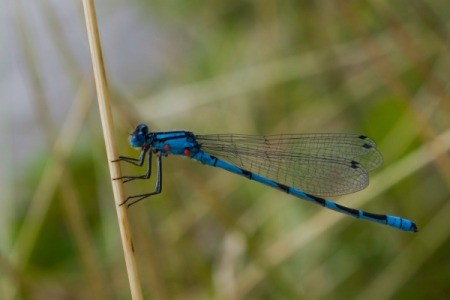
Dragonflies arrived in the garden more than 300 million years ago-a mere 70 million years before the earliest known dinosaur. With expert hunting skills (they are insect eating machines) and the ability to fly at speeds over 30 mph, it's not surprising that their species have been able to achieve such longevity. Dragonflies live, breed, and eat around water.
There are over 6000 different species of dragonflies and damselflies worldwide, 400 of which live in North America. Like bird watchers, devoted dragonfly watchers enjoy identifying and learning about the species they're watching. Dragonflies belong to an order of insects known as Odonata, which is Greek for "tooth." There are two sub-categories (or sub-orders) of dragonfly, the Anisoptera, which are the dragonflies and the Zygoptera, the damselflies.
Dragonflies are carnivorous and feed on larvae or other flying insects. Depending on the species, the lifespan of a dragonfly can be as short as six months to as long as approximately seven years. They are generally categorized into two groups:
One of the best reasons to attract dragonflies to your garden is simply to enjoy hours of entertaining insect behavior. A sturdy bench and a pair of binoculars should always be close at hand. Males defend their territory much like a male red-winged blackbird would, staking claim to an elevated perch near a pond and zooming out to chase away potential challengers. Most people are familiar with dragonfly and damselfly mating rituals, two dragonflies forming a circle or "wheel" in mid-air or in the case of damselflies, flying in tandem-one directly behind another. Much like a predatory bird, dragonflies fly over water to hunt for prey, dive-bombing it and snatching it in mid-air. With 30,000 lenses and the ability to see a full 360 degrees, it's likely that dragonflies will be watching your behavior, too!
A diverse landscape of trees, shrubs, and flowers will attract the insects to your garden that dragonflies prefer to feed on, but garden ponds will provide them with a home. Dragonflies reproduce in ponds, laying their eggs in, near, or under the pond water. They also like to hunt on or near the water. This works out well for gardeners, because they eat unwanted insects, helping to preserve the environment of a pond or garden.
If you don't already have one, creating a large pond to attract dragonflies isn't necessary. A kiddy pool or half barrel is all you need. Ideally, you pond should contain underwater plants and rocks and be a minimum of 2 ft deep. This is so dragonfly nymphs can hide from frogs, birds, predatory fish, or passing raccoons.
Plant reeds, grasses, or shrubs around the pond's perimeter to provide adult dragonflies with perches for hunting and "pond watching" and allow nymphs to crawl up out of the pond. Some species will use surrounding plants as nurseries, inserting their eggs into the more soft-stemmed plants. Dragonflies like basking in the sun, and like butterflies, they are attracted to light colored rocks. A combination of moving and still water in your pond will serve to attract the widest variety of different dragonfly species.

About The Author: Ellen Brown is an environmental writer and photographer and the owner of Sustainable Media, an environmental media company that specializes in helping businesses and organizations promote eco-friendly products and services. Contact her on the web at http://www.sustainable-media.com
Add your voice! Click below to comment. ThriftyFun is powered by your wisdom!
yay I'm the first! but you didn't have the info i was looking for. :(
I live in an apartment and only have a patio for my garden plants. How do I attract dragonflies with very limited space. Thanks
Add your voice! Click below to comment. ThriftyFun is powered by your wisdom!